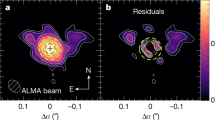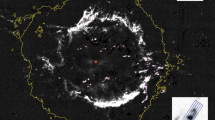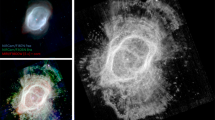Abstract
The Red Rectangle1 is the prototype of a class of carbon-rich reflection nebulae surrounding low-mass stars in the final stages of evolution. The central star of this nebula has ejected most of its layers (during the red-giant phase), which now form the surrounding cloud, and is rapidly evolving to a white dwarf. This star is also a member of a wide binary system2, which is surrounded by a thick, dusty disk of material3,4. Here we report infrared observations of the Red Rectangle that reveal the presence of oxygen-rich material: prominent emission bands from crystalline silicates, and absorption lines arising from carbon dioxide. The oxygen-rich material is located in the circumbinary disk, in contrast to the previously known carbon-rich dust, which is found mainly in the extended nebula5,6. The properties of the oxygen-rich dust are similar to those of dusty disks surrounding young stars7, which are believed to be the sites of planet formation. Grain processing, and perhaps even planet formation, may therefore also be occurring in the circumbinary disk of this evolved star.
This is a preview of subscription content, access via your institution
Access options
Subscribe to this journal
Receive 51 print issues and online access
$199.00 per year
only $3.90 per issue
Buy this article
- Purchase on Springer Link
- Instant access to full article PDF
Prices may be subject to local taxes which are calculated during checkout



Similar content being viewed by others
References
Cohen, M. et al. The peculiar object HD44179 (“The Red Rectangle”). Astrophys. J. 196, 179–189 (1975).
van Winckel, H., Waelkens, C. & Waters, L. B. F. M. The extremely iron-deficient “post-AGB” stars are binaries. Astron. Astrophys. 293, L25–L28 (1995).
Roddier, F., Roddier, C., Graves, J. E. & Northcott, M. J. Adaptive optics imaging of proto-planetary nebulae: Frosty Leo and the Red Rectangle. Astrophys. J. 443, 249–260 (1995).
Osterbart, R., Langer, N. & Weigelt, G. High resolution imaging of the bipolar nebula Red Rectangle. Evidence for unstable mass transfer in a close binary system. Astron. Astrophys. 325, 609–612 (1997).
Bregman, J. D., Rank, D., Temi, P., Hudgins, D. & Kay, L. 3.3 and 11.3 micron images of HD44179—evidence for an optically thick polycyclic aromatic hydrocarbon disk. Astrophys. J. 411, 794–796 (1993).
Sloan, G. C., Grasdalen, G. L. & Levan, P. D. Spatially resolved spectra of the unidentified infrared features around HD44179 (the Red Rectangle). Astrophys. J. 409, 412–416 (1993).
Waelkens, C. et al. SWS observations of young main sequence stars with dusty circumstellar disks. Astron. Astrophys. 315, L245–L248 (1996).
Russel, R. W., Soifer, B. T. & Willner, S. P. The infrared spectra of CRL618 and HD44179 (CRL915). Astrophys. J. 220, 568–572 (1978).
Leger, A. & Puget, J. L. Identification of the ‘undentified’ IR emission features of interstellar dust? Astron. Astrophys. 137, L5–L8 (1984).
Waelkens, C., van Winckel, H., Waters, L. B. F. M. & Bakker, E. J. Variability and nature of the Red Rectangle nebula. Astron. Astrophys. 314, L17–L20 (1996).
Bond, H. E. Chemical compositions of post-AGB stars.in Evolution of Stars: the Photospheric Abundance Connection (eds Michaud, G. & Tutukov, A. V.) 341–349 (IAU Symp. 145, Kluwer, Dordrecht, 1991).
van Winckel, H., Mathis, J. & Welkens, C. Evidence from zinc abundances for dust fractionation in chemically peculiar stars. Nature 356, 500–501 (1992).
Artymowitz, P. & Lubow, S. H. Mass flow through gaps in circumbinary disks. Astrophys. J. 467, L77–L80 (1996).
De Graauw, Th. et al. Observing with the ISO Short-Wavelength Spectrometer. Astron. Astrophys. 315, L49–L54 (1996).
Kessler, M. F. et al. The Infrared Space Observatory (ISO) mission. Astron. Astrophys. 315, L27–L31 (1996).
Beintema, D. A. et al. The rich spectrum of circumstellar PAHs. Astron. Astrophys. 315, L369–L372 (1996).
Waters, L. B. F. M. et al. Mineralogy of oxygen-rich dust shells. Astron. Astrophys. 315, L361–L364 (1996).
Koike, C., Shibai, H. & Tuchiyama, A. Extinction of olivine and pyroxene in the mid- and far-infrared. Mon. Not. R. Astron. Soc. 264, 654–658 (1993).
Jäger, C., Mutschke, H., Begemann, B., Dorschner, J. & Henning, Th. Steps toward interstellar silicate mineralogy. 1: Laboratory results of a silicate glass of mean cosmic composition. Astron. Astrophys. 292, 635–641 (1994).
Omont, A. et al. Observations of 40–70 micron bands of ice in IRAS09371 + 1212 and other stars. Astrophys. J. 355, L27–L30 (1990).
van der Veen, W. E. C. J., Waters, L. B. F. M., Trams, N. R. & Matthews, H. E. Astudy of dust shells around high latitude supergiants. Astron. Astrophys. 285, 551–564 (1994).
Jura, M., Turner, J. & Balm, S. P. Big grains in the Red Rectangle? Astrophys. J. 474, 741–748 (1997).
Reese, M. D. & Sitko, M. L. Ultraviolet and visible spectropolarimetry of the Red Rectangle and HD44179. Astrophys. J. 467, L105–L108 (1996).
Willems, F. J. & de Jong, T. Carbon stars with oxygen-rich dust shells: Evidence for the onset of the carbon star phase. Astrophys. J. 309, L39–L42 (1986).
Morris, M. Mechanisms for mass loss from cool stars. Publ. Astron. Soc. Pacif. 99, 1115–1122 (1987).
Lopez, B., Tessier, E., Cruzalebes, P., Lefevre, J. & Le Bertre, T. Dust envelope modelling of the Red Rectangle nebula. Astron. Astrophys. 322, 868–877 (1997).
Jura, M., Balm, S. P. & Kahane, C. Along-lived disk around the Red Rectangle? Astrophys. J. 453, 721–726 (1995).
Mannings, V., Koerner, D. W. & Sargent, A. I. Arotating disk of gas and dust around a young counterpart to β Pictoris. Nature 388, 555–557 (1997).
Wolszczan, A. & Frail, D. A. Aplanetary system around the millisecond pulsar PSR1257 + 12. Nature 355, 145–147 (1992).
Bradley, J. P., Brownlee, D. E. & Veblen, D. R. Pyroxene whiskers and platelets in interplanetary dust: evidence of vapour phase growth. Nature 301, 473–477 (1983).
Acknowledgements
We thank H. Dorschner for providing the laboratory spectrum of olivine. L.B.F.M.W., A.dK. and J.B. acknowledge financial support from an NWO ‘Pionier’ grant. F.J.M. acknowledges support from an NWO project grant. C.W. acknowledges financial support from the Belgian Federal Services for Scientific, Technological and Cultural Affairs, and from the Onderzoeksfonds K.U. Leuven. H.V.W. acknowledges financial support from the Fund for Scientific Research of Flanders. We thank A. Boogert for discussions on the CO2 bands in the Red Rectangle.
Author information
Authors and Affiliations
Corresponding author
Rights and permissions
About this article
Cite this article
Waters, L., Waelkens, C., van Winckel, H. et al. An oxygen-rich dust disk surrounding an evolved star in the Red Rectangle. Nature 391, 868–871 (1998). https://doi.org/10.1038/36052
Received:
Accepted:
Issue Date:
DOI: https://doi.org/10.1038/36052
This article is cited by
-
Identification of new silicate carbon stars
Astrophysics and Space Science (2011)
-
Current assessment of the Red Rectangle band problem
Astrophysics and Space Science (2009)
-
The infrared spectral features of circumstellar envelope of evolved low- and intermediate-mass stars
Science in China Series G: Physics, Mechanics and Astronomy (2008)
Comments
By submitting a comment you agree to abide by our Terms and Community Guidelines. If you find something abusive or that does not comply with our terms or guidelines please flag it as inappropriate.



